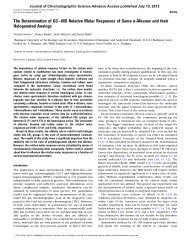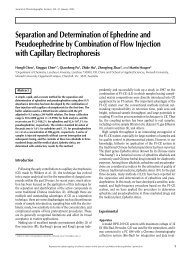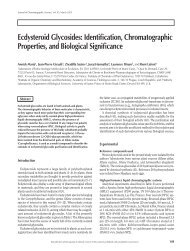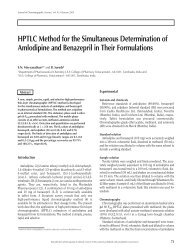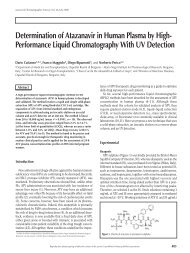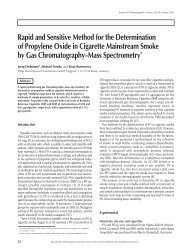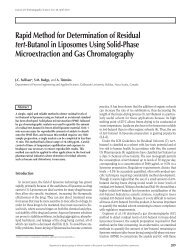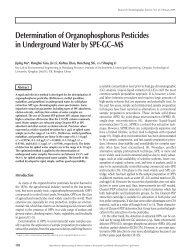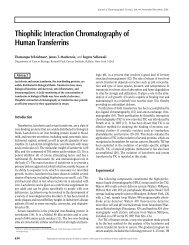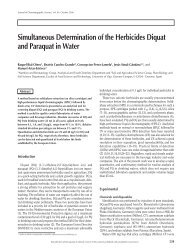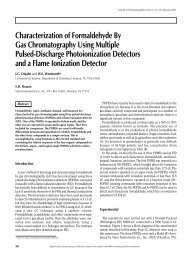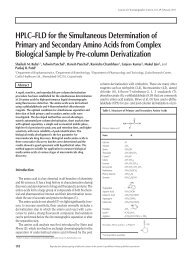Fast Gas Chromatography Analysis of N-Carbamates with Cold On ...
Fast Gas Chromatography Analysis of N-Carbamates with Cold On ...
Fast Gas Chromatography Analysis of N-Carbamates with Cold On ...
You also want an ePaper? Increase the reach of your titles
YUMPU automatically turns print PDFs into web optimized ePapers that Google loves.
Journal <strong>of</strong> Chromatographic Science, Vol. 40, July 2002<br />
<strong>Fast</strong> <strong>Gas</strong> <strong>Chromatography</strong> <strong>Analysis</strong> <strong>of</strong> N-<strong>Carbamates</strong><br />
<strong>with</strong> <strong>Cold</strong> <strong>On</strong>-Column Injection<br />
Xiling Song and Harold M. McNair<br />
Department <strong>of</strong> Chemistry, Virginia Tech, Blacksburg, VA 24061<br />
Abstract<br />
Direct gas<br />
chromatographic (GC) analysis <strong>of</strong> thermally labile<br />
N-carbamates is studied by using fast GC <strong>with</strong> cold on-column<br />
injection. With the greatly reduced injection temperature, short<br />
column lengths, high flow rate, and fast temperature-programming<br />
rate, the exposure <strong>of</strong> carbamates to high temperature is reduced and<br />
degradation can be avoided. Nine N-carbamates in EPA Method 531<br />
are eluted <strong>with</strong>out thermal decomposition. The relative standard<br />
deviation percentage for peak areas average 1.9% for all <strong>of</strong> the<br />
carbamates analyzed. A conventional GC instrument is employed to<br />
simplify the experiments. GC–mass spectrometry is used to monitor<br />
the decomposition peaks.<br />
Introduction<br />
Capillary gas chromatography (GC) is a well-established technique<br />
for the analysis <strong>of</strong> pesticides in food, soils, water, and beverages.<br />
The high resolving power <strong>of</strong> capillary columns enables the<br />
screening <strong>of</strong> a wide range <strong>of</strong> pesticides in one run, even in the<br />
presence <strong>of</strong> a complex matrix.<br />
N-<strong>Carbamates</strong> are widely used pesticides in agricultural production;<br />
however, until recently they have not been quantitated<br />
by general multiresidue methods using GC. The primary reason<br />
is their thermolability. Their chemical structures lead to degradation<br />
when applying conventional GC <strong>with</strong> hot split/splitless injectors.<br />
Therefore, almost all methods for N-carbamates employ<br />
high-performance liquid chromatography (1).<br />
Fishbein and Zielinski (2) established the mechanism responsible<br />
for the thermal degradation <strong>of</strong> N-methylcarbamates.<br />
Figure 1. Thermal decomposition <strong>of</strong> N-methylcarbamates.<br />
Phenylcarbamates are thermally decomposed into the corresponding<br />
phenol and methylisocyanate (as shown in Figure 1).<br />
Some work has been done to analyze N-carbamates by GC after<br />
derivatization (3) or on carefully deactivated capillary columns<br />
(4). Dagan and Amirav (5) reported to have analyzed carbamates<br />
by very fast and ultrafast GC coupled <strong>with</strong> supersonic mass spectrometry<br />
(MS). Special instruments were needed.<br />
The work reported in this study employs fast GC and cold oncolumn<br />
injection to minimize the exposure <strong>of</strong> carbamates at high<br />
temperature, thus minimizing thermal degradation. The effects<br />
<strong>of</strong> several factors (column length, flow rate, temperature-programming<br />
rate, as well as injector parameters) are examined and<br />
optimized.<br />
The definition <strong>of</strong> fast GC used in this study is “high-speed GC”<br />
(which refers to those analyses accomplished in several minutes<br />
compared <strong>with</strong> tens <strong>of</strong> minutes <strong>of</strong> “normal GC”) using commercially<br />
available GC instrumentation. Thus, most workers could<br />
repeat this work in their laboratory. A shorter column length,<br />
faster temperature-programming rate, and higher flow rate are<br />
commonly employed.<br />
In this study, the N-carbamate pesticides studied were<br />
propoxur, carbaryl, carb<strong>of</strong>uran, methiocarb, aldicarb, aldicarb<br />
sulfone, aldicarb sulfoxide, methomyl, and oxmyl.<br />
Experimental<br />
Instrumentation<br />
Equipment used included a Hewlett-Packard (Little Falls, DE)<br />
GC–MS Model 6890/5973 equipped <strong>with</strong> a hot split/splitless<br />
injector and an HP GC Model 6890 equipped <strong>with</strong> a cold oncolumn<br />
injector. Hot split/splitless injection and cold on-column<br />
injection were both studied.<br />
Experimental conditions<br />
HP-5 fused-silica columns were used in all analyses. Three<br />
column lengths (30, 10, and 7 m) were employed, all <strong>of</strong> which had<br />
the same internal diameter (0.25 mm) and film thickness (0.25<br />
Reproduction (photocopying) <strong>of</strong> editorial content <strong>of</strong> this journal is prohibited <strong>with</strong>out publisher’s permission.<br />
321
µm). The flow rate, temperature-programming rate, and other<br />
parameters varied <strong>with</strong> different column parameter and injection<br />
techniques.<br />
Materials<br />
Propoxur (98%) was purchased from Ultra Scientific (North<br />
Kingstown, RI). Carbaryl (1000 µg/mL), carb<strong>of</strong>uran (1000<br />
µg/mL), methiocarb (1000 µg/mL), aldicarb (100 µg/mL),<br />
aldicarb sulfone (100 µg/mL), aldicarb sulfoxide (100 µg/mL),<br />
methomyl (100 µg/mL), and oxmyl (100 µg/mL) were purchased<br />
from Absolute Standards, Inc. (Hamden, CT). Propoxur was dis-<br />
Figure 2. Chromatogram <strong>of</strong> propoxur analyzed by conventional GC–MS <strong>with</strong> a<br />
high-temperature-programming rate <strong>of</strong> 100°C/min.<br />
Figure 3. Chromatogram <strong>of</strong> carbaryl analyzed by conventional GC–MS <strong>with</strong> a<br />
high-temperature-programming rate <strong>of</strong> 100°C/min.<br />
Figure 4. Chromatogram <strong>of</strong> carb<strong>of</strong>uran analyzed by conventional GC–MS <strong>with</strong><br />
a high-temperature-programming rate <strong>of</strong> 100°C/min.<br />
322<br />
solved in methanol to be 100 µg/mL; carbaryl, carb<strong>of</strong>uran, and<br />
methiocarb were diluted by methanol to 100 µg/mL. In order to<br />
further confirm the daughter peaks, the phenols resulting from<br />
the thermal degradation <strong>of</strong> the carbamates were purchased from<br />
ACROS Organics (Suwanee, GA).<br />
Results and Discussion<br />
Journal <strong>of</strong> Chromatographic Science, Vol. 40, July 2002<br />
The 30-m-long capillary column was installed in the GC–MS<br />
Figure 5. Chromatogram <strong>of</strong> methiocarb analyzed by conventional GC–MS <strong>with</strong><br />
a high-temperature-programming rate <strong>of</strong> 100°C/min.<br />
Figure 6. Chromatogram <strong>of</strong> propoxur analyzed by conventional GC–MS <strong>with</strong> a<br />
temperature-programming rate <strong>of</strong> 10°C/min.<br />
Figure 7. Chromatogram <strong>of</strong> carbaryl analyzed by conventional GC–MS <strong>with</strong> a<br />
temperature-programming rate <strong>of</strong> 10°C/min.
Journal <strong>of</strong> Chromatographic Science, Vol. 40, July 2002<br />
system <strong>with</strong> a heated split/splitless injector. Propoxur, carbaryl,<br />
carb<strong>of</strong>uran, and methiocarb were employed first to investigate<br />
the direct GC method. They were chromatographed separately<br />
under both a high-temperature programming rate <strong>of</strong> 100°C/min<br />
and a normal rate <strong>of</strong> 10°C/min. Other experimental conditions<br />
were kept the same: the injector was set at 250°C, the initial oven<br />
temperature was 70°C, an MS was used in scan mode, the carrier<br />
gas was helium at 28 cm/s, and the injection volume was 1 µL.<br />
These conditions were used to monitor the thermal decomposition<br />
products <strong>of</strong> carbamates.<br />
Figures 2, 3, 4, and 5 are the chromatograms <strong>of</strong> the four N-carbamates<br />
analyzed by the conventional GC–MS <strong>with</strong> a hightemperature<br />
programming rate <strong>of</strong> 100°C/min. In the chromatograms,<br />
D (“daughter”) indicates the decomposed compound<br />
and P (“parent”) indicates the original carbamate.<br />
All four carbamates showed thermal decomposition under the<br />
conditions used. Propoxur and carb<strong>of</strong>uran were totally decomposed.<br />
Most <strong>of</strong> methiocarb was decomposed, and carbaryl was<br />
eluted as a major parent peak.<br />
By changing the temperature-programming rate from<br />
100°C/min to 10°C/min, the thermal decomposition <strong>of</strong> all four<br />
carbamates was minimized (although they were still partially<br />
decomposed). Figures 6, 7, 8, and 9 show these chromatograms.<br />
The high temperature <strong>of</strong> both the injector and column oven led<br />
to the thermal decomposition <strong>of</strong> the carbamates, and the higher<br />
Figure 8. Chromatogram <strong>of</strong> carb<strong>of</strong>uran analyzed by conventional GC–MS <strong>with</strong><br />
a temperature-programming rate <strong>of</strong> 10°C/min.<br />
Figure 9. Chromatogram <strong>of</strong> methiocarb analyzed by conventional GC–MS <strong>with</strong><br />
a temperature-programming rate <strong>of</strong> 10°C/min.<br />
temperature-programming rate made the decomposition even<br />
worse. The elution order <strong>of</strong> the carbaryl parent and daughter peak<br />
was reversed at different temperature-programming rates<br />
(Figures 3 and 7). The same change happened to methiocarb<br />
(Figures 5 and 9), which may result from the large programming<br />
rate change.<br />
When we reduced the temperature <strong>of</strong> the injector to 200°C,<br />
thermal decomposition still occurred. A 10-m column <strong>with</strong> cold<br />
on-column injection was then used to study the four carbamate<br />
standards under increasing temperature-programming rates<br />
(50°C/min, 80°C/min, and 100°C/min in order to study this<br />
parameter). Other experimental conditions were kept the same:<br />
the initial oven temperature was 60°C and then programmed to<br />
230°C, the injector was in track oven mode, a flame ionization<br />
Figure 10. Chromatogram <strong>of</strong> carbaryl analyzed by GC <strong>with</strong> a cold on-column<br />
injector at a temperature-programming rate <strong>of</strong> 50°C/min.<br />
Figure 11. Chromatogram <strong>of</strong> carbaryl analyzed by GC <strong>with</strong> a cold on-column<br />
injector at a temperature-programming rate <strong>of</strong> 80°C/min.<br />
Figure 12. Chromatogram <strong>of</strong> carbaryl analyzed by GC <strong>with</strong> a cold on-column<br />
injector at a temperature-programming rate <strong>of</strong> 100°C/min.<br />
Figure 13. Chromatogram <strong>of</strong> a carb<strong>of</strong>uran analyzed by GC <strong>with</strong> a cold oncolumn<br />
injector at a temperature-programming rate <strong>of</strong> 50°C/min.<br />
323
detector was used at 280°C, the time constant was at 50 Hz, the<br />
carrier gas was helium at 60 cm/s, and the injection volume was<br />
1 µL.<br />
Figures 10, 11, and 12 are the chromatograms <strong>of</strong> carbaryl analyzed<br />
by GC <strong>with</strong> a cold on-column injection. The initial oven<br />
temperature was 60°C and was then ramped at different temper-<br />
Figure 14. Chromatogram <strong>of</strong> methiocarb analyzed by GC <strong>with</strong> a cold oncolumn<br />
injector at a temperature-programming rate <strong>of</strong> 50°C/min.<br />
Figure 15. Chromatogram <strong>of</strong> carb<strong>of</strong>uran analyzed by GC <strong>with</strong> a cold oncolumn<br />
injector at a lower elution temperature.<br />
Figure 16. Chromatogram <strong>of</strong> methiocarb analyzed by GC <strong>with</strong> a cold oncolumn<br />
injector at a lower elution temperature.<br />
Table I. %RSD* <strong>of</strong> Direct GC Injections for Nine<br />
<strong>Carbamates</strong> by Peak Area and Retention Time<br />
324<br />
Retention %RSD %RSD<br />
time (min) (peak area) (retention time)<br />
Propoxur 3.16 1.1 0.17<br />
Carbaryl 2.48 1.8 0.19<br />
Carb<strong>of</strong>uran 2.12 1.3 0.12<br />
Methiocarb 3.33 1.2 0.13<br />
Aldicarb 1.85 2.6 0.08<br />
Aldicarb sulfone 1.95 2.9 0.04<br />
Aldicarb sulfoxide 1.47 1.3 0.05<br />
Methomyl 1.36 2.1 0.12<br />
Oxmyl 1.49 2.7 0.13<br />
* n = 5.<br />
Journal <strong>of</strong> Chromatographic Science, Vol. 40, July 2002<br />
ature-programming rates to 230°C and then held for 1 min. The<br />
increasing elution temperature (T R) <strong>with</strong> the faster programming<br />
rate should be noted. At 100°C/min, the first evidence <strong>of</strong> a<br />
daughter peak can be seen, indicating that a T R <strong>of</strong> 230°C is too hot<br />
for carbaryl.<br />
When analyzed by fast GC <strong>with</strong> a cold on-column injection<br />
technique at a temperature-programming rate <strong>of</strong> 50°C/min and<br />
80°C/min, carbaryl eluted <strong>with</strong>out thermal decomposition<br />
(Figures 10 and 11). When the temperature-programming rate<br />
increased to 100°C/min, a big daughter peak eluted (Figure 12).<br />
For propoxur, there was no decomposition at 50°C/min; however,<br />
the daughter appeared <strong>with</strong> a programming rate <strong>of</strong> 80°C/min and<br />
became bigger at 100°C/min. This result can be explained by the<br />
T R, which is the temperature at which the peak elutes. Thus, the<br />
faster the temperature-programming rate is, then the higher the<br />
T R and the worse the thermal decomposition will be. Therefore,<br />
carbaryl must be eluted at 214°C or even lower. The maximum T R<br />
for propoxur is 225°C.<br />
Carb<strong>of</strong>uran and methiocarb were studied under the same conditions,<br />
and daughter peaks were found at all temperature-programming<br />
rates (Figures 13 and 14).<br />
It should be noted that the elution order <strong>of</strong> the carbaryl parent<br />
and daughter peak at 100°C/min was the same as that at<br />
100°C/min when using a 30-m-long column (Figure 7). However,<br />
the methiocarb parent eluted before the daughter, which was the<br />
same as the elution order at 100°C/min using the 30-m-long<br />
column (Figure 5). The reason for the elution order change is not<br />
clear; the big change in temperature-programming rate and<br />
column length may play an important role.<br />
Even fast GC <strong>with</strong> cold on-column injection could not prevent<br />
the thermal decomposition <strong>of</strong> carb<strong>of</strong>uran and methiocarb under<br />
the specified conditions. An even lower T R is needed. In order to<br />
lower the T R, a shorter, 7-m-long column, a slower temperatureprogramming<br />
rate (35°C/min), and a faster linear velocity (75<br />
cm/s) were employed. The initial oven temperature was set at<br />
60°C then ramped at 35°C/min to 200°C and held for 2 min.<br />
Both carb<strong>of</strong>uran and methiocarb were swept quickly out <strong>of</strong> the<br />
column at lower T R values (134°C and 169°C, respectively). No<br />
thermal decomposition occurred (Figures 15 and 16).<br />
The four carbamates together <strong>with</strong> other N-carbamates<br />
(aldicarb, aldicarb sulfone, aldicarb sulfoxide, oxmyl, and<br />
methomyl) were studied separately for the precision <strong>of</strong> the peak<br />
area and retention time under the same experimental conditions<br />
developed for the 7-m column. The relative standard deviation<br />
percentage (%RSD) (n = 5) for the peak area and retention time<br />
were calculated and are listed in Table I.<br />
All nine carbamates were eluted <strong>with</strong>out undergoing degradation<br />
by using fast GC <strong>with</strong> cold on-column injection. The %RSD<br />
for the peak area was between 1% and 3% for all nine carbamates.<br />
The linearity was demonstrated by solutions <strong>of</strong> 0.5 µg/mL, 10<br />
µg/mL, 50 µg/mL, 80 µg/mL, and 100 µg/mL, and the correlation<br />
coefficients to straight lines were > 0.98. The detection limit was<br />
calculated statistically as three times the noise level, which was <<br />
100 ppb. Both linearity and limit <strong>of</strong> detection studies were performed<br />
on four carbamates: propoxur, carbaryl, carb<strong>of</strong>uran, and<br />
methiocarb.<br />
The results presented in this study are acceptable and suggest<br />
the possibility <strong>of</strong> the quantitative analysis <strong>of</strong> thermolabile carba-
Journal <strong>of</strong> Chromatographic Science, Vol. 40, July 2002<br />
mates by fast GC <strong>with</strong> cold on-column injection, and it also would<br />
be a good choice for other thermolabile pesticides or pharmaceutical<br />
products.<br />
References<br />
1. J. Sherma. Pesticides. Anal. Chem. 67: 1R–20R (1995).<br />
2. L. Fishbein and W.L. Zielinski, Jr. Structural transformations during<br />
gas chromatography <strong>of</strong> carbamates. Chromatographia 2: 38–56<br />
(1969).<br />
3. E. Ballesteros, M. Gallego, and M. Valcarcel. Automatic gas chromatographic<br />
determination <strong>of</strong> N-methylcarbmates in milk <strong>with</strong> electron<br />
capture detection. Anal. Chem. 65: 1773–78 (1993).<br />
4. O. Wuest and W. Meier. GC <strong>Analysis</strong> <strong>of</strong> N-carbamates using deactivated<br />
capillary column. Z. Lebensm. Unters. Forsch. 177: 25–29<br />
(1983).<br />
5. S. Dagan and A. Amirav. <strong>Fast</strong>, very fast and ultra-fast gas chromatography–mass<br />
spectrometry <strong>of</strong> thermally labile steroids, carbamates,<br />
and drugs in supersonic molecular beams. J. Am Soc. Mass<br />
Spectrom. 7: 737–52 (1996).<br />
Manuscript accepted March 28, 2002.<br />
325



